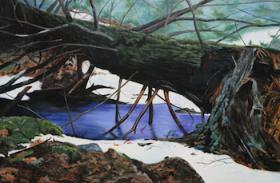 November’s exhibit in the Gallery at the Garden (Robert H. Gibson River Garden, 157 Main St.) features works by painter and set designer Clay Coyle in a show titled Fresh Paint: Reflections of Color in Landscapes and Trees.
November’s exhibit in the Gallery at the Garden (Robert H. Gibson River Garden, 157 Main St.) features works by painter and set designer Clay Coyle in a show titled Fresh Paint: Reflections of Color in Landscapes and Trees.
Concurrently, the River Garden, home of Strolling of the Heifers, will host an exhibit of historical materials from the archives of Kurn Hattin Homes for Children, the Westminster residential school for children at-risk or in need. Established in 1894, Kurn Hattin serves boys and girls, ages 5-15, who are affected by tragedy, social or economic hardship, or other disruption in family life.
Now a resident of Venice, Florida, Coyle maintains a studio in Putney and just recently moved from his S. Londonderry, Vermont homestead which he had kept since 1980. Clay has actively painted and worked on set and lighting design since he entered Williams College in 1968. He graduated in 1972, winning the Gilbert W. Gabriel Prize in Drama for his design and technical work. From Williams he headed to New York City where he designed sets for the Classic Stage Company, the New Dramatists Inc., the Producer’s Association for Young America, the Spanish Repertory Company, and others.
Clay’s classical education came into play as he found himself designing for works by Shakespeare, Moliere, Ibsen, Wedekind, and a host of contemporary playwrights who were at the forefront of New York’s Off Broadway Theater. He also worked for summer stock houses in New Hampshire and Pennsylvania in addition to working with The Kanawaha Valley Players in his home town of Charleston, W.V.
Tiring of the hustle and bustle of New York City, Clay sought a more tranquil life in South Londonderry, where once again he could “see the clouds sail by and marvel at the beauty of the stars at night.” In his 1880’s farmhouse and attached barn he found the space and time he needed to pursue his interest in painting more fully than he had been able to in New York.
After ten years of focusing on his painting skills, Clay once again turned to theater design and worked with Whetstone Theater Company in Brattleboro and later Lost Nation Theater in Montpelier where he is still designing scenery and lighting.
In his early years in Vermont, he put together large sized painting extravaganzas with emphasis on the characters and colors of the Circus. He has one series of paintings called Sideshow which includes the characters Ozzie (the human skeleton), Etta Lake (the rubber faced girl), Scatongo (the Wildman of Borneo), Madame Le Fair (the bearded lady), Jacques (the long headed man) and Lucia Zarate (the ant woman).
Circus imagery has continued as an element in his work, along with political and psychological themes and fantasy.
Clay’s paintings have been exhibited in diverse galleries such as the Wyland Gallery in Key West, Fl., the Tartan Pony Gallery in Santa Fe, N.M., and in Vermont at the Southern Vermont Arts Center and Vermont Woods Gallery in Manchester, the Chaffee Art Center in Rutland, and Vermont Artisan Designs in Brattleboro.
In March of this year Clay designed the set and lights for the play Cabin Fever (staged at the River Garden by Snack Theater) in a benefit production for Strolling of the Heifers.
For his show at the River Garden, Clay has gathered a selection of paintings that relate to the land. “I find it fascinating,” he says, “that one can put together a very abstract collection of dots and slashes of color on canvas or board and have a viewing mind see a world it recognizes and responds to.”
“All paintings are abstract works,” he writes in his artist’s statement. “Some paintings look ‘realistic’ in that the colors and shapes are organized in such a way that our brains jump to conclusions and we ‘see’ something that isn’t really there, at least not in the way we think it is. I like the illusions that art brings to us because those illusions can be more powerful and moving than what we see in ‘reality’. Art helps us focus our attentions and intentions and that is what creates communication and knowledge, all of which leads to a rich experience.”
Created this year to celebrate the 120th anniversary of Kurn Hattin’s founding, the historical exhibit, entitled A Legacy of Caring: Adapting to the Changing Needs of Children and Families, features a curated selection of photos, records, and documents from Kurn Hattin Homes’ archives, dating from the late 1800s through the present.
With firsthand accounts and audio-visual elements, the exhibit tells the story of Kurn Hattin’s founding and development within the context of major events in Vermont and U.S. history, such as World Wars I and II, the Great Depression, and the Civil Rights Movement, as well as significant trends in the fields of child care, education, and social services since the turn of the 19th century that have helped to shape the organization’s philosophy and approach.
A public reception will be held for the exhibit opening at the River Garden on Thursday, November 6 from 5:30 – 7:00. The reception will be hosted by Kurn Hattin Homes for Children’s Executive Director, Connie Sanderson, and will feature a brief presentation and Q and A session. Refreshments will be provided. All are welcome to attend.
Both exhibits will remain on view through the end of November. The River Garden will be open during Gallery Walk on November 7 from 5:30 to 8:30 p.m. Normal hours are Monday through Friday 9 a.m. to 5 p.m., Saturday 11 a.m. to 5 p.m., and Sunday 1:30 to 3:30 p.m., except when the space is rented out for special events.
Information: 802-246-0982; on the Web: www.strollingoftheheifers.com, www.kurnhattin.org.








